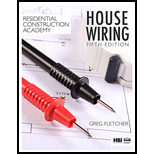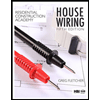
Concept explainers
The five common types of cable used in residential wiring along with their NEC® article for each cable.
Explanation of Solution
The common types of cable used in residential wiring are as follows:
- Nonmetallic sheathed cable
- Power and control tray cable
- Underground feeder cable
- Armored cable
- Metal-clad cable
Nonmetallic sheathed cable
The installation specifications for nonmetallic sheathed cable are covered in Article 334 of the NEC®. Type NM cable is permitted to be used in one- and two-family houses which include detached or attached garages and storage buildings, according to Section 334.10(1).
Power and control tray cable
The National Electrical Code now enables Type TC cable to be used in one- and two-family dwelling units under Section 336.10(9). Type TC cable is defined as a factory assembly of two or more insulated conductors, with or without associated grounding conductors, underneath a nonmetallic jacket, as defined in Section 336.2.
Underground feeder cable
Type UF cable can be utilized in house wiring for direct burial purposes or for wiring scenarios where nonmetallic sheathed cable would ordinarily be utilized, according to Article 340 of the NEC®. Section 300.5 must be applied for underground installation standards.
Armored cable
Armored cable, often known as "BX" cable by electricians, can be used in a house either concealed or exposed. Exposed Type AC wire must closely follow the building finish surface or be attached to running boards according to Section 320.15.
Metal-clad cable
The other type of cable where some electricians use for house wiring is metal-clad cable. The NEC® specifies certain installation criteria for Type MC Cable in Article 330.
Conclusion:
The five common types of cable used in residential wiring are nonmetallic sheathed cable, power and control tray cable, underground feeder cable, armored cable and metal-clad cable.
Want to see more full solutions like this?
Chapter 11 Solutions
Residential Construction Academy: House Wiring (MindTap Course List)
- 1500 N A B 3500 N/m 1.2 m 3.6 m 1.2 m 1800 N Beam Cross-section: 4b T D b 25 mm 100 mm For beam ABCD with cross-section shown, design the beam by determining the following: Draw the shear and bending moment diagrams (show your detailed computations to get credit) The minimum dimension for b [mm], knowing that the allowable flexural stress and transverse shear stress are 10 MPa and 0.5 MPa, respectively.arrow_forwardCivil engineering quantiarrow_forwardPlease answer the questions in the picture. Thank you for your help. For part B use the Second Picture.arrow_forward
- Derive by deconvolution the six-hour unit hydrograph from the following data for a watershed having a drainage area of 216 km2 , assuming a constant rainfall abstraction rate and a constant baseflow of 20 m3 /s. Six-hour period 1 2 3 4 5 6 7 8 9 10 11 Rainfall (cm) 1.5 3.5 2.5 1.5 Streamflow (m3 /s) 26 71 174 226 173 99 49 33 26 22 21 Use the unit hydrograph developed to calculate the streamflow hydrographfrom a 12 hour-duration storm having 2 cm of rainfall excess in the first six hours and 3 cm inthe second six hours. Assume a constant baseflow rate of 30 m3/s.arrow_forwardPlease answer the following question in the picture. Thank you for your help.arrow_forwardGiven the unit hydrographic in the table, calculate the streamdlow hydrographic from a 12 hour duration story having 2cm of rainfall excess in the first six hours and 3cm in the second six hours. Assume a constant base flow rate of 30 m3/sarrow_forward
- Based on the following information, what is the owner’s equity? Current Assets: $162,000Current Liabilities: $91,000 Fixed Assets: $290,000 long-Term Debt: $140,000arrow_forwardPlease refer to the below figure. Use f y = 60,000 psi and f c′ = 3000 psi. Each web is reinforced with 2-#4 rebars in one layer. (a) Use the entire flange width as effective. Determine if the interior Double-Tee beam behaves as a T-beam or rectangular beam. (b) Determine the design moment strength of the section. Hint: You can collapse the two webs in a single web as discussed in class.arrow_forwardGrade is being established to the bottom of a footing that is 24” thick. The elevation of thetop of the footing is 102.33’. the elevation of the existing grade is 106.14’. the backsight of thesurveying instrument on a benchmark of 100.00’ is 6.78’. what is the correct reading for the rodat the bottom of the footing?arrow_forward
- 6.48 This "double" nozzle discharges water (p = 62.4 lbm/ft³) into the atmosphere at a rate of 16 cfs. If the nozzle is lying in a horizontal plane, what X-component of force acting through the flange bolts is required to hold the nozzle in place? Note: Assume irrotational flow, and assume the water speed in each jet to be the same. Jet A is 4 in. in diameter, jet B is 4.5 in. in diameter, and the pipe is 1.4 ft in diameter. A 30°F B Problem 6.48 Xxarrow_forward6-1 For the rectangular beam shown in Fig. P6-1, (a) Draw a shear-force diagram. (b) Assuming the beam is uncracked, show the direction of the principal tensile stresses at middepth at points A, B, and C. (c) Sketch, on a drawing of the beam, the inclined cracks that would develop at A, B, and C. 10 kips A B 1 kip/ft 7.5 ft Fig. P6-1 + 7.5 ft 6 ft 10 kipsarrow_forward6.85 A reducing pipe bend is held in place by a pedestal as shown. There are expansion joints at sections 1 and 2, so no force is transmitted through the pipe past these sections. The pressure at section 1 is 20 psig, and the rate of flow of water (p = 62.4 Ibm/ft³) is 2 cfs. Find the force and moment that must be applied at section 3 to hold the bend stationary. Assume the flow is irrotational, and neglect the influence of gravity. 6 in. diameter + 24 in. 24 in. (3 4 in. diameter Problem 6.85arrow_forward
 Residential Construction Academy: House Wiring (M...Civil EngineeringISBN:9781337402415Author:Gregory W FletcherPublisher:Cengage Learning
Residential Construction Academy: House Wiring (M...Civil EngineeringISBN:9781337402415Author:Gregory W FletcherPublisher:Cengage Learning Residential Construction Academy: House Wiring (M...Civil EngineeringISBN:9781285852225Author:Gregory W FletcherPublisher:Cengage Learning
Residential Construction Academy: House Wiring (M...Civil EngineeringISBN:9781285852225Author:Gregory W FletcherPublisher:Cengage Learning

